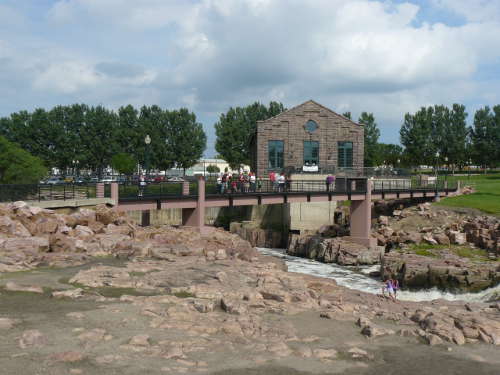 Location Taken: Sioux Falls, South Dakota
Location Taken: Sioux Falls, South Dakota
Time Taken: June 2010
It’s really easy to forget just how much of a role water plays in where cities grow and flourish. These days, cities spread out across a wide area, and any rivers or bays or whatnot, well, unless they’re large enough for a major port, they’re all fancied up into parks and the like. It’s tough to put anything along the edge of a river, thanks to the rough terrain and the risk of flooding and the ilk.
The pretty parts of the rivers, like the waterfalls that oh so many places are named after, they have the best parks, with fantastic refurbished buildings from a century or more ago forming a picturesque scene right near the waterfall. They’re great places to take your mind off work and relax.
Which is the exact opposite of what these buildings started as. In the days before electric power, the best form of power for factories was waterfalls.
If you found a waterfall, especially in areas like eastern South Dakota, solidly part of the rather flat Great Plains, well, you settled there. And build power plants on the river, and factories right next to them. And houses all around. The best places, you could build a small dock a little downriver from the falls and ship out your goods by boat all the way to New Orleans and beyond.
It’s that last aspect that really made the difference for the largest cities, especially on the East Coast of the USA. If you look at a map, you can see that all the large cities from New York City to Atlanta are all on a rough line that parallels not the coast, but the Appalachian Mountains. They’re all located right at the furthest spot you could take a boat up whatever large river each city is associated with. Well, with a few exceptions. There’s some that are port cities, such as New York, Baltimore, and Wilmington. Where’s Wilmington, you say? It’s just the largest city in Delaware, right next to Philadelphia. It’s got a much better access to the sea than Philly, but it’s the smaller of the pair. It’s the City of Brotherly Love that has the better mix of sea and river travel, so it grew powerful in the days when the boat was king. As for New York and Baltimore, well, they both are at a spot that’s both a great port and right near the waterfalls coming off the mountains. New York also has the Hudson, which literally cut its way right through the mountains, with its waterfalls far far away from the port at its mouth.
These days, it’s tough to find some of the waterfalls that formed these cities. They’re tucked away in a corner, out of sight. There may be a canal system dug to allow boats to travel even further upriver. Even these days a large amount of goods get hauled on barges, despite all the advances in rail and road and airplanes. It’s all a matter of what route is best for the goods involved, and the port cities on both ocean and river still reap benefits from these small threads of water running through their midst.
